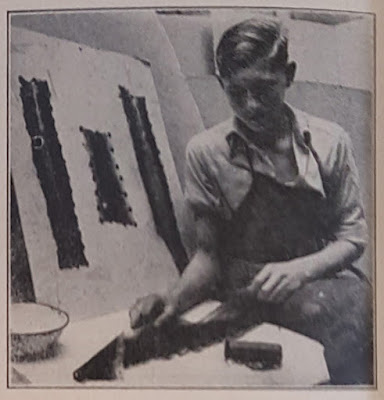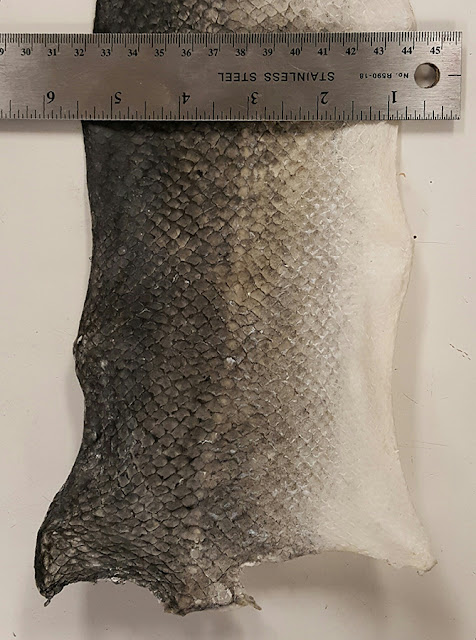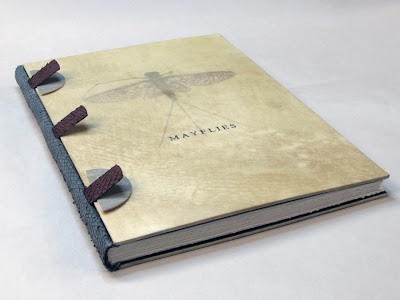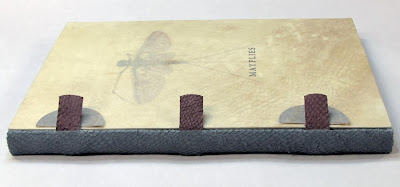Inzwischen sollten alle wissen, daß ich so eine verspinnerte Vorliebe für die Verwendung von Fischleder... an Einbänden habe. Ein Grund mag sein, daß es so anders ist und von fast niemanden mehr verwendet wird. Der größere Grund mag die Verbindung zu Ernst Collin sein der bekanntlich einige Aufsätze über Fischleder in der Buchbinderei geschrieben hat. Ich habe über diese zuerst 2014 in dem Aufsatz Something Fishy - Fish Leather for Binding geschrieben mit weiteren Aufsätzen wo ich meine Anwendungen beschrieben habe. Neulich fand ich beim Durchblättern meiner Buchbinderlehrling Jahrgängen (1927-43) einen kurzen Aufsatz über "Fips" und die Aalhaut. Ich habe schon einig Male Aalhaut verwendet (sehr dünn, aber stark), ideal für Edelpappbände, aber dieser war der erste Aufsatz in dem beschrieben wurde wie aus Fischhaut Pergament gemacht wurde. In den meisten Aufsätzen die ich bis jetzt gesehen habe ging es eher ums Gerben, aber in allen Fällen mit wenigen Details. Als Lehrling im dritten Jahr wollte "Fips" sich etwas besonderes für seinen Einband vom Buchbinderlehrling für den jährlichen Lehrlingswettbewerb ausdenken. Aus verschiedenen Gründen kam er zur Aalhaut. Also, ab zum benachbarten Fischhändler. Ein ganz dicker sollte es sein, aber ohne Fleisch, Gräten, und Innereien... Die hat er von dem verdutztem Fischweib sogar kostenlos bekommen. Also zurück in den Betrieb um die Haut zu reinigen (zum Eckel aller) und aufzuspannen. So einfach war das.
 |
| "Fips" setting out his eel skin to dry in the sun. "Fips" beim Aufspannen seiner Aalhäuten. |
Judging by the picture in the article (above), perhaps the eels fattened themselves after the Battle of Jutland.
Dem Bild oben nach wurde sein Aal vielleicht von der Skagerrakschlacht so fett.
Friend and colleague Monica Langwe in Sweden sent me these pictures of fish parchment she had, so I now had a sense of what I was aiming towards. Nice to see the unique textures I was used to from working with fish leather in the parchment, too.
Meine Freundin und Kollegin Monica Langwe in Schweden schickte mir diese Bilder von Ihrer Fischpergmenthaut. Jetzt hatte ich eine Ahnung wie das Ganze aussehen sollte. Schön auch zu sehen, daß die eigenartige Oberflächenstruktur wie beim Leder erhalten ist.
| Fish parchment detail | Fischpergament Detailansicht |
 |
| View of overall skin | Gesamt Ansicht des Pergaments |
Also, vor einigen Tagen wurde das Auto meiner Frau in einen Parkplatz mit dem Laster vom Seefruchthändler versteuert... Unter den Muscheln und Jakobsmuscheln war auch eine bescheidene Seite atlantischen Lachs mit der Haut dran. Sie wusste von meinen verspinnerten Projekten und wollte mich sticheln... Also Muscheln gegessen, und dann ran die Arbeit den Lachs zu enthäuten...
 |
| Pulling the skin off. Beim Enthäuten. |
 | |
| Almost done – I rewarded my helper with scraps of sashimi Fast fertig –Meinen Helfer habe ich mit Sashimiresten gefüttert. |
 |
| The skin being cleaned after removal. Nach der Enthäutung fing die Reinigung an. |
 |
| The skin stretched out to dry in the sun under tension, just like "Fips'" skin. The Haut unter Spannung in die Sonne zwecks trocknung gelegt, so wie "Fips" es auch gemacht hat. |
 |
| In for the night, nice and taut. Will it pass the dog test, will Loki lick it? Rein für die Nacht. Wird es das Schnüffeltest bestehen, wird Loki es lecken? |
This morning I found several greasy spots that I cleaned, and then out in the sun it went again.
Heute Morgen einige fettige Stellen gefunden die ich gereinigt habe, dann wieder raus in die Sonne.
 |
| Recto |
 |
| Verso |
 |
| Detail |
Book Arts arts du livre Canada (Vol 10., Nr. 2, 2019)
"Fish Tales, experiments with fish skin for bookbinding
The New Bookbinder: Journal of Designer Bookbinders (2020)
"Random" Fish Leather Related Links:"Fish Tales, experiments with fish skin for bookbinding
The New Bookbinder: Journal of Designer Bookbinders (2020)
- Fish Leather by Nienke Hoogvliet
- Egg tanning
- http://www.instructables.com/id/Urine-Tanned-Salmon-Leather/
- https://www.google.com/search?q=+fish+leather&ie=utf-8&oe=utf-8
- http://www.ebay.com/bhp/fish-skin-leather
- http://paleoplanet69529.yuku.com/topic/34478/Tanning-Fish#.T7wMahxa4k9
- http://with-water.blogspot.com/2012/05/diy-fish-leather.html
- http://www.fiskurleather.com/about-us.html
- http://www.atlanticleather.is/
- https://www.sealeatherwear.com/
- https://www.visleer.nl/
- https://reliuredartdare.com/tag/peau-de-poisson/























